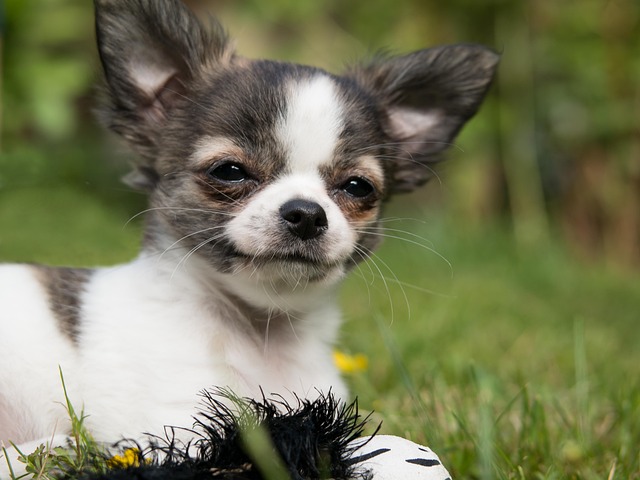Have you ever seen a Chihuahua do a funny hop or suddenly start walking like they’ve got something stuck on their paw? It might be more than just a quirky trait. In the world of small breeds, particularly Chihuahuas, patella luxation is a common knee-jerk issue – literally. Therefore, let’s discover everything you need to know about Chihuahua patella luxation, and how to ensure your tiny companion stays happy and healthy.

Why Do Chihuahuas Get Patella Luxation?
It’s in the Genes
First off, genetics play a significant role. It’s like inheriting your grandma’s love for knitting, but in this case, it’s a predisposition for knee problems.
Environmental Factors and Physical Strain
Then there’s the environmental aspect. Slippery floors are like banana peels for these little guys, and high jumps? Think of them as tiny Evel Knievels without the safety gear. These factors can contribute to or worsen patella luxation.

Spotting the Signs: Is My Chihuahua Doing the Luxation Limbo?
Limping or Abnormal Gait
If your Chihuahua starts walking like they’re auditioning for a zombie movie, pay attention. Limping or an odd gait can be a red flag.
Skipping and Hopping
Notice your Chihuahua skipping steps or hopping? They’re not practicing for a dance-off; they might be trying to realign that kneecap.
Reluctance to Jump
If your usually acrobatic Chi suddenly turns down an invitation to jump onto the couch, it’s not because they’ve lost their love for leaps – their knees might just be bothering them.
Visible Signs of Pain and Discomfort
Yelping, licking, or biting at the knee area are all SOS signals. And if you see stiffness, especially after a nap, it’s a sign that something’s up.
Less Pep in Their Step
A less active Chihuahua is a sign that moving around might be painful. And if you spot swelling or a knee that’s out of place, it’s time for a vet visit.
“I’m Not My Usual Self!”
Lastly, don’t ignore changes in behavior. A grumpy or less sociable Chi might be in discomfort.
Diagnosing the Dilemma
Think of your vet as a detective. They’ll do a physical exam, and might even bring out the big guns – X-rays – to see what’s going on with those tiny knees.
Top 5 Treatments: Getting Back on Track
Conservative Management: The ‘No Surgery’ Route
Think of this as the ‘let’s not rush into surgery’ approach. Weight management and gentle exercise are key here. Remember, every pound on a Chihuahua is like a backpack full of rocks on their tiny knees.
Physical Therapy: Knee Gymnastics
Physical therapy is like a gym membership for your Chi’s knees. Strengthening exercises can do wonders, just don’t expect them to start lifting weights.
Have you ever had one of those days where you feel like you’ve been run over by a truck, and the only thing that can save you is a tiny pill? Well, guess what? Our furry friends have those days too! When your Chihuahua is giving you the “help me” eyes, sometimes medications are their knight in shining armor.

But here’s the catch – these patients are tiny! So, when your vet hands over a prescription, it’s not time to play mad scientist. You’ve got to follow those dosage instructions as if they were written in stone. Types of Medications for Small Dogs:
- Pain Relievers: These are like the superhero capes for dogs in pain.
- Anti-Inflammatory Drugs: Think of these as the peacekeepers in the wild west of your dog’s body.
- Supplements: These aren’t just your average vitamins; they’re like the secret weapon for joint health.
Surgical Options: When It’s Time to Operate
The word “surgery” might send shivers down your spine, but in the dog world, it’s sometimes the expressway to recovery. If your Chi’s knees are more problematic than a toddler in a candy store, surgery might be the best option.
Think of it as a pit stop in a race. It might seem scary, but it’s just what your Chi needs to get back in the game. And hey, they might come back with some cool stories to tell their dog friends!
Common Surgeries for Knee Issues:
- Ligament Repair: This is like fixing a broken swing in the playground of your dog’s knee.
- Joint Replacement: Sounds extreme, but it’s like getting a brand new, state-of-the-art knee!

Holistic Approaches: The Natural Path
Holistic treatments of Chihuahua patella luxation are like the spa day your dog never knew they needed. It’s all about getting back to the basics and treating the body as a whole.
- Supplements: From glucosamine to omega fatty acids, these are like the multivitamins for superdogs.
- Acupuncture: Yes, dogs can have acupuncture too! It’s like tiny magic needles doing wonders.
- Physical Therapy: Think of it as yoga for dogs. Relaxing, beneficial, and maybe a little bit funny to watch.
Recovery and Post-Treatment Care of Chihuahua Patella Luxation
After any treatment, it’s time for your Chi to channel their inner diva – rest, relaxation, and being waited on hand and foot. This is when your living room turns into a luxury spa, minus the cucumber water and massages.
Key Post-Treatment Care Tips:
- Rest: Your dog needs to chill out, like they’re on a beach holiday.
- Follow-Up Visits: These are like the progress reports in school, but for your dog’s health. Ufortunately, this is one of the most common health issues in Chihuahuas.
- Medication Management: If there are meds to take, remember, you’re the pharmacist now.
Prevention Strategies: Avoiding the Slippery Slope
Prevention is the unsung hero in the world of Chihuahua Patella Luxation. It’s like putting a seatbelt on your Chi every day. Here’s how to keep those tiny knees as sturdy as a tree:
Balanced Diet for Your Chi: Just like you, your Chi needs to eat right. Think of it as fueling a tiny sports car.
Low-Impact Exercise: This isn’t about training for a doggy marathon, but keeping those joints moving smoothly.
Regular Vet Check-Ups: These are like the annual car service, but for your dog.
Life with a Luxating Patella: The Daily Adventures
Living with a Chihuahua with patella luxation can be like navigating a miniature obstacle course. You’ll need to be on the lookout for signs of discomfort, and sometimes play the role of a cheerleader, encouraging them to move gently. Think of it as having a tiny athlete in the house – one who occasionally needs a pep talk and a bit of TLC.
Home Adjustments: Making Your Home Chi-Friendly
Consider making some adjustments at home. Ramps or steps to their favorite spots can prevent risky leaps. Non-slip mats can be a game-changer on those slippery floors – think of them as mini runways for safer landings.
Diet and Exercise: The Balancing Act
Balancing their diet and exercise is crucial. Overfeeding your Chi is a major no-no. You don’t want your adorable pup turning into a burrito with legs. Many studies have shown that feeding a dog with raw diet can keep their weight within optimal ranges. So, why not switch your Chi to this type of diet? By putting your dog on a raw diet, you’ll have ‘’the privilege’’ of choosing special ingredients with a lower calorie index.
We also give an advantage to reward your Chi with fresh veggies and fruits instead of commercial ones. Not only they’re a healthier option, but are also lower in calories. We recommend you choose blueberries, carrots, apples and other natural ingredients for rewarding.
Exercise is the next piece of the puzzle. While Chihuahuas aren’t exactly the marathon runners of the dog world, they still need their fair share of exercise.
- Exercise Tips:
- Gentle walks: Regular but gentle strolls are perfect. Imagine a leisurely walk in the park, not a race.
- Watch for signs: If your Chi starts limping, it’s time to hit the pause button on the walk.
Regular Vet Visits: Keeping Up with Check-Ups
Think of regular vet visits as your Chi’s personal health audits. These visits are like those catch-up coffee dates with friends, except here, the coffee is replaced with stethoscopes and health charts.
Chihuahua Patella Luxation: Wrapping Up
It’s crucial to remember that dealing with Chihuahua patella luxation isn’t just about managing a medical condition. It’s about enhancing your furry friend’s quality of life. Sure, there will be days when you feel like a nurse, a therapist, and a personal trainer all rolled into one. But at the heart of it all, it’s about making sure your Chi feels loved, comfortable, and happy.


3 thoughts on “Chihuahua Patella Luxation: Reasons and Top 5 Treatments”